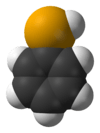Benzeneselenol
| |||
| Names | |||
|---|---|---|---|
| IUPAC name
benzeneselenol | |||
| Other names
Selenaphenol, selenophenol, phenylselenol | |||
| Identifiers | |||
| 645-96-5 | |||
| 3D model (Jmol) | Interactive image | ||
| ChemSpider | 62734 | ||
| ECHA InfoCard | 100.010.417 | ||
| PubChem | 69530 | ||
| |||
| |||
| Properties | |||
| C6H6Se | |||
| Molar mass | 157.07 g/mol | ||
| Appearance | colorless liquid | ||
| Density | 1.479 g/cm3 | ||
| Boiling point | 71 to 72 °C (160 to 162 °F; 344 to 345 K) (18 mm Hg) | ||
| slightly | |||
| Solubility in other solvents | most organic solvents | ||
| Refractive index (nD) |
1.616 | ||
| Structure | |||
| 1.1 D | |||
| Hazards | |||
| Main hazards | toxic | ||
| R-phrases | R23/25-R33-R50/53 | ||
| S-phrases | S20/21-S28-S45-S60-S61 | ||
| Related compounds | |||
| Related compounds |
Thiophenol, Hydrogen selenide, Diphenyl diselenide | ||
| Except where otherwise noted, data are given for materials in their standard state (at 25 °C [77 °F], 100 kPa). | |||
| | |||
| Infobox references | |||
Benzeneselenol is the organoselenium compound with the formula C6H5SeH, often abbreviated PhSeH. It is the selenium analog of the simple aromatic alcohol phenol, and the related thiol thiophenol. This colourless, intensely malodorous compound is a useful reagent in organic synthesis.[1]
Synthesis and basic properties
Benzeneselenol is prepared via the reaction of phenylmagnesium bromide and selenium:[2]
- PhMgBr + Se → PhSeMgBr
- PhSeMgBr + HCl → PhSeH + MgBrCl
More so than thiophenol, benzeneselenol is easily oxidized by air. The product is diphenyl diselenide as shown in this idealized equation:
- 4 PhSeH + O2 → 2 PhSeSePh + 2 H2O
The presence of the diselenide is indicated by a yellow coloration in most samples of PhSeH. The diselenide can be converted back to the selenol by reduction followed by acidification of the resulting PhSe−.
PhSeH is approximately seven times more acidic than the related thiophenol. Both compounds dissolve in water upon the addition of base.
In organic synthesis benzeneselenol is converted to its conjugate base PhSe−, a potent nucleophile.[1]
History
Benzeneselenol was first reported in 1888 by the reaction of benzene with selenium tetrachloride (SeCl4) in the presence of aluminium trichloride (AlCl3).[3][4]
Safety
The compound is intensely malodorous[5] and, like other organoselenium compounds, toxic.
References
- 1 2 Sonoda, N.; Ogawa, A.; Recupero, F. (2005). "Benzeneselenol". In L. Paquette. Encyclopedia of Reagents for Organic Synthesis. New York: J. Wiley & Sons. doi:10.1002/047084289X.rb018.pub2.
- ↑ Foster, D. G. (1944). "Selenophenol". Org. Synth. 24: 89.; Coll. Vol., 3, p. 771
- ↑ Chabrié, M. C. (1888). "Premiers essais de synthèse de composés organiques séléniés dans la série aromatique". Bulletin de la Société Chimique de Paris. 50: 133–137.
- ↑ Chabrié, M. C. (1890). "Sur la synthèse de quelques composés séléniés dans la série aromatique". Annales de Chimie et de Physique. 6 (20): 202–286.
- ↑ Lowe, D. (2012-05-15). "Things I wont work with: Selenophenol". In the Pipeline.

